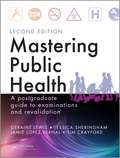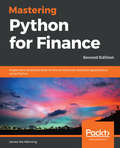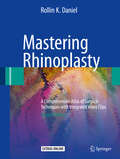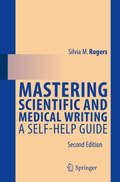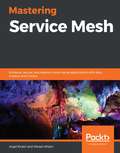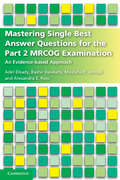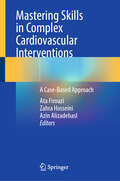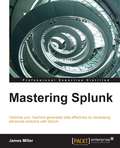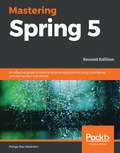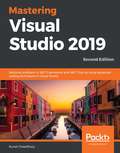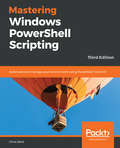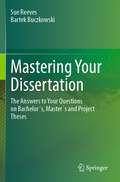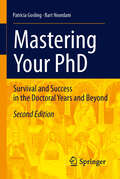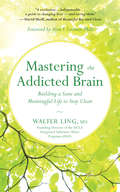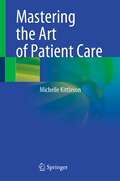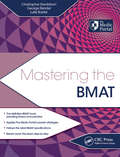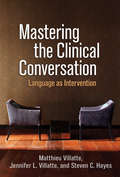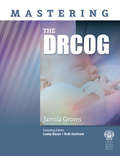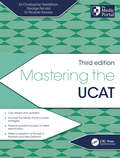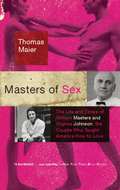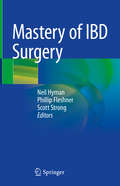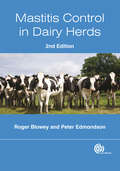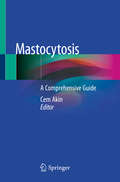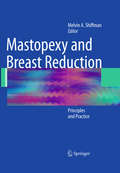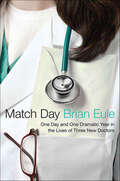- Table View
- List View
Mastering Public Health: A Postgraduate Guide to Examinations and Revalidation, Second Edition
by Geraint Lewis Jessica Sheringham Jamie Lopez Bernal Tim CrayfordMastering Public Health: A Postgraduate Guide to Examinations and Revalidation, Second Edition is an essential study aid for all those preparing for postgraduate, masters, and higher examinations in public health. Now updated and revised for the second edition, the book continues to provide all postgraduate students taking higher public health exam
Mastering Python for Finance: Implement advanced state-of-the-art financial statistical applications using Python, 2nd Edition
by James Ma WeimingTake your financial skills to the next level by mastering cutting-edge mathematical and statistical financial applicationsKey FeaturesExplore advanced financial models used by the industry and ways of solving them using PythonBuild state-of-the-art infrastructure for modeling, visualization, trading, and moreEmpower your financial applications by applying machine learning and deep learningBook DescriptionThe second edition of Mastering Python for Finance will guide you through carrying out complex financial calculations practiced in the industry of finance by using next-generation methodologies. You will master the Python ecosystem by leveraging publicly available tools to successfully perform research studies and modeling, and learn to manage risks with the help of advanced examples.You will start by setting up your Jupyter notebook to implement the tasks throughout the book. You will learn to make efficient and powerful data-driven financial decisions using popular libraries such as TensorFlow, Keras, Numpy, SciPy, and sklearn. You will also learn how to build financial applications by mastering concepts such as stocks, options, interest rates and their derivatives, and risk analytics using computational methods. With these foundations, you will learn to apply statistical analysis to time series data, and understand how time series data is useful for implementing an event-driven backtesting system and for working with high-frequency data in building an algorithmic trading platform. Finally, you will explore machine learning and deep learning techniques that are applied in finance.By the end of this book, you will be able to apply Python to different paradigms in the financial industry and perform efficient data analysis.What you will learnSolve linear and nonlinear models representing various financial problemsPerform principal component analysis on the DOW index and its componentsAnalyze, predict, and forecast stationary and non-stationary time series processesCreate an event-driven backtesting tool and measure your strategiesBuild a high-frequency algorithmic trading platform with PythonReplicate the CBOT VIX index with SPX options for studying VIX-based strategiesPerform regression-based and classification-based machine learning tasks for predictionUse TensorFlow and Keras in deep learning neural network architectureWho this book is forIf you are a financial or data analyst or a software developer in the financial industry who is interested in using advanced Python techniques for quantitative methods in finance, this is the book you need! You will also find this book useful if you want to extend the functionalities of your existing financial applications by using smart machine learning techniques. Prior experience in Python is required.
Mastering Rhinoplasty
by Rollin K. DanielEvery surgeon who carries out rhinoplasty procedures will learn a great deal from this book. The beginner is guided through the performance of a standard rhinoplasty operation that can be expanded to incorporate the described advanced techniques as experience is gained. Here, the emphasis is on the routine case that is too frequently overlooked in favor of the esoteric. For the already proficient surgeon, on the other hand, the latest breakthroughs in the management of difficult cases, such as saddle nose, skin sleeve problems, and dorsal grafting, are clearly depicted. When appropriate, approaches developed exclusively by the author are presented. The lucid text is complemented by a wealth of color figures.
Mastering Scientific and Medical Writing
by Silvia M. RogersThis self-help guide is intended for scientists and medical professionals and students who wish to improve their scientific writing skills. Exercises invite the reader to practice the most important aspects of scientific writing. Although the book addresses certain issues more troublesome to scientific communicators of a non-English language origin, the guide will be of equal benefit to those whose first language is English. If you want not only to write but to write well, this book is for you. This second edition takes into account new developments in the area of scientific communication. In particular, the importance of authenticity is addressed, drawing attention to the sensitive issue of plagiarism in scientific texts.
Mastering Service Mesh: Enhance, secure, and observe cloud-native applications with Istio, Linkerd, and Consul
by Anjali Khatri Vikram Khatri Dinesh Nirmal Hamid Pirahesh Eric HernessUnderstand how to use service mesh architecture to efficiently manage and safeguard microservices-based applications with the help of examples Key Features Manage your cloud-native applications easily using service mesh architecture Learn about Istio, Linkerd, and Consul – the three primary open source service mesh providers Explore tips, techniques, and best practices for building secure, high-performance microservices Book Description Although microservices-based applications support DevOps and continuous delivery, they can also add to the complexity of testing and observability. The implementation of a service mesh architecture, however, allows you to secure, manage, and scale your microservices more efficiently. With the help of practical examples, this book demonstrates how to install, configure, and deploy an efficient service mesh for microservices in a Kubernetes environment. You'll get started with a hands-on introduction to the concepts of cloud-native application management and service mesh architecture, before learning how to build your own Kubernetes environment. While exploring later chapters, you'll get to grips with the three major service mesh providers: Istio, Linkerd, and Consul. You'll be able to identify their specific functionalities, from traffic management, security, and certificate authority through to sidecar injections and observability. By the end of this book, you will have developed the skills you need to effectively manage modern microservices-based applications. What you will learn Compare the functionalities of Istio, Linkerd, and Consul Become well-versed with service mesh control and data plane concepts Understand service mesh architecture with the help of hands-on examples Work through hands-on exercises in traffic management, security, policy, and observability Set up secure communication for microservices using a service mesh Explore service mesh features such as traffic management, service discovery, and resiliency Who this book is for This book is for solution architects and network administrators, as well as DevOps and site reliability engineers who are new to the cloud-native framework. You will also find this book useful if you're looking to build a career in DevOps, particularly in operations. Working knowledge of Kubernetes and building microservices that are cloud-native is necessary to get the most out of this book.
Mastering Single Best Answer Questions for the Part 2 MRCOG Examination: An Evidence-Based Approach
by Adel Elkady Bashir Dawlatly Ahmed Mustafa H. Rees Alexandra E. Mustafa H. ReesThis comprehensive question-and-answer resource covers all aspects of the curriculum for the Part 2 MRCOG examination. Candidates are given the opportunity to practise the Single Best Answer question style, to cover the content they will encounter in the examination and to assess their knowledge. As consultants actively engaged in the writing of the Part 2 Single Best Answers, the authors and editor have provided directly applicable questions. Candidates to review the syllabus in an organised, systematic manner, with comprehensive explanations for each answer. This title also includes new sections on ethics, training, audit and clinical governance. Mock exams are also available online to familiarise candidates with the real-life examination. The detailed answers, evidence and comprehensive list of references offer an excellent training and reading source for all candidates preparing for the Part 2 MRCOG examination.
Mastering Skills in Complex Cardiovascular Interventions: A Case-Based Approach
by Azin Alizadehasl Ata Firouzi Zahra HosseiniThis book presents a collection of cases in which advanced cardiology interventional procedures have been used to manage a range of clinical scenarios. Chapters detail how to perform each procedure in an easy-to-follow step-by-step format, and go on to describe potential pitfalls and how to incorporate relevant imaging techniques. For every technique described, key procedural points are provided to assist the reader in developing an understanding of how to manage these situations. Topics covered include coronary artery interventions for calcified lesions, chronic total occlusion lesions and transcatheter valvular interventions. Mastering Skills in Complex Cardiovascular Interventions: A Case-Based Approach is a practically applicable guide on how to utilize a range of advanced interventional cardiology techniques, making it an indispensable reference for all trainee and practicing interventional cardiology practitioners, cardiac surgeons and all cardiovascular professionals.
Mastering Splunk
by James MillerThis book is for those Splunk developers who want to learn advanced strategies to deal with big data from an enterprise architectural perspective. You need to have good working knowledge of Splunk.
Mastering Spring 5: An effective guide to build enterprise applications using Java Spring and Spring Boot framework, 2nd Edition
by Ranga Rao KaranamBuild scalable and flexible Rest APIs and microservices using the latest versions of Spring and Spring Boot Key Features Build Java-based enterprise applications using Spring 5.1 and Spring Boot 2.1 Create high performing, reusable, and scalable enterprise Java applications that are easy to test Gain powerful insights into advanced Spring and Spring Boot concepts to develop applications effectively Book Description Spring 5.1 is the latest release of the widely used Spring Framework. This book takes you through the evolution of building enterprise-ready applications with Spring and Spring Boot. Mastering Spring 5 starts with an overview of some of the important Spring Framework features relating to aspect-oriented programming, task scheduling, and scripting with the help of practical examples. You'll learn about the standard dependency injection specification for Java contexts and CDI and how the Spring Framework supports it. You'll gain an understanding of how application architectures have evolved from monoliths to microservices and be able to build your own microservices using Spring Boot. Complete with real-world examples, this book will help you gain powerful insights into Spring Boot 2.1 and learn how to develop cloud-native microservices with Spring Cloud. You'll even explore how to secure a REST API with Spring Security and get started with your first full stack application using React. Furthermore, you'll get to grips with Kotlin fundamentals and build a Kotlin project in Eclipse. By the end of this book, you'll be equipped with all the knowledge required to develop microservices and full stack applications with the Spring Framework. What you will learn Explore Spring Framework 5.1 features such as AOP, transaction management, task scheduling, and scripting Build REST APIs and microservices with Spring and Spring Boot Develop a secure REST API with Spring Security Build your first full stack React application Write efficient unit tests with Spring and Spring Boot Understand the advanced features that Spring Boot offers to develop and monitor applications Use Spring Cloud to deploy and manage applications on the Cloud Who this book is for This book is for experienced Java and enterprise Java developers and programmers who have a basic understanding of the Spring Framework.
Mastering Visual Studio 2019 - Second Edition
by Kunal ChowdhuryMicrosoft .NET Developers who would like to learn the new features of Visual Studio 2019, and would like to delve into newer areas such as cloud computing, .NET Core, TypeScript, along with mastering the skills of building, debugging and unit testing professional apps, would benefit from this book. Basic knowledge of Visual Studio, .NET and C# is assumed.
Mastering Windows PowerShell Scripting: Automate and manage your environment using PowerShell Core 6.0, 3rd Edition
by Chris DentGrasp advanced PowerShell Core 6.0 functionalities to automate your environmentKey FeaturesKeep up with changes introduced in PowerShell Core 6.0Easily maintain appropriate compatibility with older versionsAutomate complex tasks, manipulate data, and secure your environment with PowerShell Core 6.0Book DescriptionPowerShell scripts offer a handy way to automate various chores, however working effectively with these scripts can be a difficult task.This comprehensive guide starts with the fundamentals before moving on to advanced-level topics to help you become a PowerShell Core 6.0 expert. The first module, PowerShell Core 6.0 Fundamentals, begins with the new features of PowerShell Core 6.0, installing it on Linux, and working with parameters, objects and .NET classes from within PowerShell Core 6.0. As you make your way through the chapters, you'll see how to efficiently manage large amounts of data and interact with other services using PowerShell Core 6.0. You'll be able to make the most of PowerShell Core 6.0's powerful automation feature, where you will have different methods available to parse data and manipulate regular expressions and Windows Management Instrumentation (WMI). After having explored automation, you will enter the extending PowerShell Core 6.0 module, covering asynchronous processing and desired state configuration. In the last module, you will learn to extend PowerShell Core 6.0 using advanced scripts and filters, and also debug issues along with working on error handling techniques.By the end of this book, you will be an expert in scripting with PowerShell Core 6.0.What you will learnOptimize code through the use of functions, switches, and looping structuresWork with objects and operators to test and manipulate dataParse and manipulate different data typesCreate scripts and functions using PowerShellUse jobs, events, and popular public modules which assist with implementing multithreadingWrite .NET classes with ease within the PowerShellCreate and implement regular expressions in PowerShell scriptsMake use of advanced techniques to define and restrict the behavior of parametersWho this book is forIf you are a system administrator who wants to become an expert in controlling and automating your Windows environment, then Mastering Windows PowerShell Scripting is for you. It is also ideal for those new to the PowerShell language.
Mastering Your Dissertation: The Answers to Your Questions on Bachelor´s, Master´s and Project Theses
by Sue Reeves Bartek BuczkowskiThis reader-friendly guide is specifically designed for any student who has ever had a question about theses as part of their university undergraduate degree course in a life- or health science-related subject. It covers the varied types of projects that exist, including experimental work, surveys, meta-analyses, audits and qualitative and quantitative studies - all in one place.Get support at planning, completing and writing of your research based thesis. By using examples and check lists, this book leads you through the entire process encompassing each chapter of the dissertation. Let the question and answer writing style encourage you and boost your confidence when embarking on what is probably your largest piece of work to date, solved in a step by step approach.The experienced authors have run an enormous number of web and face-to-face workshops to support students in life and health sciences and help them write their dissertations. It became clear that research theses are a considerable source of anxiety and that many essential questions need answering - this book is your solution.
Mastering Your PhD
by Lambertus D. Noordam Patricia Gosling"Mastering Your PhD: Survival and Success in the Doctoral Years and Beyond" helps guide PhD students through their graduate student years. Filled with practical advice on getting started, communicating with your supervisor, staying the course, and planning for the future, this book is a handy guide for graduate students who need that extra bit of help getting started and making it through. While mainly directed at PhD students in the sciences, the book's scope is broad enough to encompass the obstacles and hurdles that almost all PhD students face during their doctoral training. Who should read this book? Students of the physical and life sciences, computer science, math, and medicine who are thinking about entering a PhD program; doctoral students at the beginning of their research; and any graduate student who is feeling frustrated and stuck. It's never too early -- or too late! This second edition contains a variety of new material, including additional chapters on how to communicate better with your supervisor, dealing with difficult people, how to find a mentor, and new chapters on your next career step, once you have your coveted doctoral degree in hand.
Mastering the Addicted Brain: Building a Sane and Meaningful Life to Stay Clean
by Walter LingFor anyone trying to overcome an addiction, living with someone with an addiction, or helping someone with an addictionAs most drug and alcohol addicts eventually realize, good intentions alone aren't enough to break destructive habits. However, addiction can be managed once its true nature is understood. This simple yet profound guidebook takes you step-by-step through the process of building a life after addiction by adopting new behaviors that create lasting change. An internationally renowned psychiatrist, neurologist, and addiction specialist, Dr. Walter Ling has worked with thousands of addicts, their loved ones, and fellow clinicians. His no-nonsense, no-judgment approach, which he calls the "neuroscience of common sense," advocates holistic methods to prevent relapse and establish new patterns to create a sustainable, meaningful life.
Mastering the Art of Patient Care
by Michelle KittlesonLike a mentor you may turn to in times of crisis, this book provides the wisdom earned from countless mentors and patients. You may be standing on the precipice of medical training or well into your career, trying to recapture the joy of medicine. A love of people and a love of science barely capture the essence of a life in medicine; there is so much more to being a physician than the ability to diagnose and treat diseases.While nothing can fully prepare you for the fear and anxiety that comes with inexperience, Mastering the Art of Patient Care eases some of that uncertainty with a system for surviving and thriving in medical school and beyond. Whatever your stage, the goal of this book is to share successes and failures to help you be a physician who takes outstanding care of patients, colleagues, and trainees and derives great joy from saving lives.
Mastering the BMAT (Mastering)
by Christopher Nordstrom George Rendel Luke BaxterThis is the first BMAT theory and practice book on the market, providing not only practice questions but breaking down the BMAT exam step-by-step. The authors, both leading specialists in BMAT training, focus on each section in turn, using many sample questions to carefully illustrate the theory rather than simply testing rote learning. A concluding mock exam allows candidates to consolidate learning through self-assessment, with model answers to refer to at the end.
Mastering the Clinical Conversation
by Steven C. Hayes Matthieu Villatte Jennifer L. VillatteThis compelling book provides psychotherapists with evidence-based strategies for harnessing the power of language to free clients from life-constricting patterns and promote psychological flourishing. Grounded in relational frame theory (RFT), the volume shares innovative ways to enhance assessment and intervention using specific kinds of clinical conversations. Techniques are demonstrated for activating and shaping behavior change, building a flexible sense of self, fostering meaning and motivation, creating powerful experiential metaphors, and strengthening the therapeutic relationship. User-friendly features include more than 80 clinical vignettes with commentary by the authors, plus a "Quick Guide to Using RFT in Psychotherapy" filled with sample phrases and questions to ask.
Mastering the DRCOG (Mastering)
by Jamila GrovesMastering the DRCOG directly reflects and fulfils the DRCOG syllabus set by the Royal College of Obstetricians and Gynaecologists. Chapters are laid out precisely following the DRCOG syllabus format. Starting with an overall introduction to the exam, Mastering the DRCOG covers the seven core modules of the syllabus:Basic Clinical SkillsBasic S
Mastering the UCAT, Third Edition (Mastering)
by Christopher Nordstrom George Rendel Ricardo TavaresDrawing on The Medic Portal’s established track record, the third edition of this popular revision aid, retitled Mastering the UCAT to reflect the extension of the former UK-specific exam to prospective medical and dental students in Australia and New Zealand, takes you, step by step, through the proven techniques that have already helped thousands of our students achieve top scores. Our expert authors deconstruct all question types before leading you through core strategies, common pitfalls and top tips – as well as the tactics examiners use to trip you up.
Masters of Sex
by Thomas MaierIn Masters of Sex, critically acclaimed biographer Thomas Maier offers an unprecedented look at William Masters and Virginia Johnson, their pioneering studies of intimacy, and the sexual revolution they inspired. Masters and Johnson began their secret studies in a small Midwest laboratory, and soon became the nation’s top experts on sex. Over the course of more than forty years, they analyzed and explained the secrets of orgasm, emotional fulfillment, and sexual dysfunction. But they divorced after twenty years amid a clash of success, betrayal, and jealousies. Weaving interviews with the notoriously private William Masters and the ambitious Virginia Johnson, Maier offers a titillating portrait of the legendary couple. Entertaining, revealing, and beautifully told, this groundbreaking book sheds light on the eternal mysteries of desire and intimacy, and their complicated roles in the American psyche.
Mastery of IBD Surgery
by Neil Hyman Phillip Fleshner Scott StrongThis book provides a guide to the management of patients with Crohn’s disease and ulcerative colitis. The indications for surgery within inflammatory bowel disease are covered, as well as new biologic medications and the effects they have on the immune system. Details on how these drugs should be managed to avoid complications and ensure patient safety are also included. Mastery of IBD Surgery sets out to cover surgical responses to inflammatory bowel disease from a multidisciplinary perspective and aims to help all surgeons and medical professionals working in this area. This book is relevant to colorectal surgeons, gastrointestinal surgeons, and gastroenterologists.
Mastitis Control in Dairy Herds
by Peter Edmondson Roger BloweyMastitis in dairy herds is a worldwide problem, with significant implications for milk yields and quality, economic losses, and animal health and welfare. Effective control makes a considerable difference to the farmer and the animal, and this new edition includes updated information throughout as well as new chapters covering organic dairy herds, dry period infections, robotic milking, residue avoidance, and best practice procedures. The authors, both fellows of the Royal College of Veterinary Surgeons and recognised experts in the field, provide basic principles relevant to farmers, vets and veterinary students in a clear and practical way, covering anatomy, epidemiology, milking machines, disinfection, somatic cell counts, and diseases of the udders and teats in order to provide a thorough understanding of the causes of mastitis and measures of control and prevention. It is an indispensable resource for large animal vets, dairy industry personnel, farm managers, dairy herdsmen, and researchers and students in animal sciences and related disciplines.
Mastocytosis: A Comprehensive Guide
by Cem AkinThis unique book offers an in-depth, best-practices guide to diagnosis and management of mastocytosis, a too-often underdiagnosed disease.Mastocytosis: A Comprehensive Guide will open with a general overview and discussion of mast cell biology, addressing tryptase and other diagnostic markers in detail. Comprehensive diagnostic criteria and classification will follow, with special emphasis on commonly-seen related manifestations: skin disease, pediatric mastocytosis, gastrointestinal indicators, osteoporosis, anaphylaxis, venom and drug allergy, and pregnancy. Mastocytosis will be an ideal resource for not only the allergist confronted with this condition, but for a growing, multi-disciplinary audience of hematologists, gastroenterologists, dermatologists, pediatricians, primary care providers and other clinicians who encounter this disease in their patients.
Mastopexy and Breast Reduction
by Melvin A. ShiffmanThis comprehensive guide covers all aspects of mastopexy and breast reduction, ranging from anatomy to the variety of procedures in mastopexy, mastopexy/breast reduction, and breast reduction, preoperative care, complications, breast tumors (benign and malignant), and medicolegal aspects.
Match Day: One Day and One Dramatic Year in the Lives of Three New Doctors
by Brian EuleThree new doctors—all women—struggle to balance professional ambitions and personal relationships, triumphs and crises, uncertainties and decisions, through one pressure-packed day and the first year of their careers in medicine Each year, on the third Thursday in March, more than 15,000 graduating medical students exult, despair, and endure Match Day: the decision of a controversial computer algorithm, which matches students with hospital residencies in every field of medicine. The match determines where each graduate will be assigned the crucial first job as an intern, and shapes the rest of his—or, in increasing number, her—life. In Match Day, Brian Eule follows three women from the anxious months before the match through the completion of their first year of internship. Each woman makes mistakes, saves lives, and witnesses death; each must keep or jettison the man in her life; each comes to learn what it means to heal, to comfort, to lose, and to grieve, while maintaining a professional demeanor. Just as One L became the essential book about the education of young attorneys, so Match Day will be for every medical student, doctor, and reader interested in medicine: a guide to what to expect, and a dramatic recollection of a pressured, perilous, challenging, and rewarding time of life.
